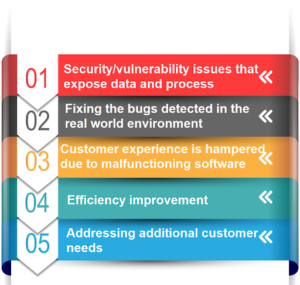Accelerate Success with AI-Powered Test Automation – Smarter, Faster, Flawless
Start free trialA few years back, a lesser-known fact about the Titanic disaster was highlighted in a documentary aired by the National Geographic channel. It spoke about how one ignored and undermined problem in one part of the ship resulted in a big tragedy and multiple casualties. The engineers ignored the possibility of the weakened ship frame due to the bulkhead fire and the ship was allowed to sail after routine checks. Unfortunately, that proved to be their undoing and the rest is history as we know it. Similarly, in the world of software, any bugs or changes in one module/feature can also affect or break the functionalities of other features.
Often, there are instances when there is an urgent need to rectify issues or upgrade certain functionality in a software application. Hotfixes come to the rescue when time is of the essence. Hotfixes, like any other piece of code, have to undergo a thorough testing process before they can be applied to any application.
What are Hotfixes?
A hotfix is a small set of code that addresses issues, if any, or introduces minor changes in an already functioning software application, without waiting for the next major release.
Some of the scenarios where hotfix is needed are listed below:

Following factors have to be considered while making the decision to release hotfixes:
- Risk of introducing potential bugs: Adding hotfixes can cause a critical error and may damage the functionality at some other part of code. However, if the risk involved in fixing is lesser than the impact of malfunction/bug, then it is worth taking the shot.
- Quantum of time and efforts involved: The whole evaluation process and designing of test cases need to execute one more time, and this procedure needs extra time and effort of the team.
- Cost-effectiveness: In some cases, it turns out to be an expensive option, since resources and time have to be allocated to address them on a priority basis. This may hamper the planning of any other ongoing project. However, if the time and cost involved to fix is achievable, then it is a good idea to go ahead with the fix.
As stated above, there is always a risk of jeopardizing an already fully functional application if hotfixes are applied without proper testing.
Choosing The Right Testing Approach for Hotfixes

To handle the inadvertently introduced bugs, it is a good idea to have partial regression testing including HIGH priority end to end scenarios.
There are multiple ways of identifying partial regression testing scenarios:
- Specific modules impacted by the change
- High priority end-to-end scenarios from complete application
- Impacted dependent as well as error-prone areas
Partial regression testing focuses on newly added functionalities and features. The process includes selecting some high priority test cases that include new modifications and related modules, that might get affected by the changes. It aims at improving overall quality by conducting an end to end verification of the system and ensures that all the reported issues have been fixed.
Smoke testing is also beneficial for testing small modules and checking all functions end-to-end. On top of that, full regression testing is a great practice to test the overall features of an application.

Conclusion
Webomates offers regression testing as a service that is a combination of test cases based on testing and exploratory testing. Test cases based testing establishes a baseline and uses a multi-execution channel approach, to reach true pass / true fail, using AI Automation, automation, manual, and crowdsourcing.
Webomates CQ provides services like Overnight Regression, that is conducted on specific modules, which can be either a fully developed module or work-in-progress module. The advantage of using our product is that it takes less time than a full regression cycle, and testing can be completed within 8-12 hours. In addition, the development team gets a detailed execution report along with the defects report.
Exploratory testing expands the scope of the test to take the quality to the next level. This also ensures that the complete application is working fine and at least tested once without leaving any doubt for any critical error. Service is guaranteed to do both and even covers updating test cases of modified features.
If you are interested in learning more about Webomates’ CQ service please click here and schedule a demo, or reach out to us at info@webomates.com

Leave a Reply